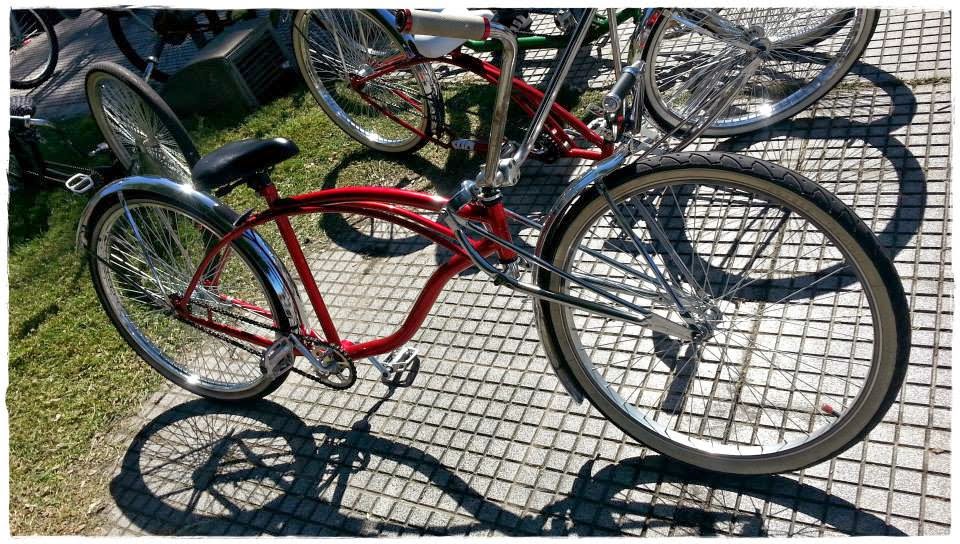Coaster Hub Overhaul (Pedal Brake Hub)
Typical Tools and Supplies Needed:
Cone wrenches. 15mm commonly required.
Wrenches for axle nuts
Bench vise
Straight blade screwdriver
Park Tool axle and pedal vise AV-1 or AV-4
Grease, Park Tool Polylube® 1000
Solvent, such as ChainBrite® CB-2
Rags
This article with discuss the basic bearing service of coaster-brake hubs. This is also referred to as a "back pedaling brake." The hub contains internal brake shoes housed inside a metal shell. A clutch mechanism allows the hub to engage and drive the bike foward. The clutch then disengages for coasting or braking. Rotating the pedals backwards expands the brake shoes into the steel hub in order to slow the bike. These types are of hubs are not considered "high performance", and are limited in their ability to stop the bike.
This vid show´s the system working:
A basic coaster hub is seen below. As the bicycle is pedalled forward, the sprocket turns the driver into the clutch. The clutch end is serrated with sharp teeth and these literally jam into the hub shell, turning the shell and wheel forward. When the pedals stop turning, the clutch pulls away from the hub shell. If the pedals are moved backwards, the clutch pushes into the brake shoes. The shoes are pushed outward into the shell. As the shoes drag against the shell, they attempt to turn the left side cone. There is a long brake arm that is fixed against the frame of the bike to prevent the left cone from turning. There can be a substantial amount of friction inside the shell. It is important to grease the shoes, bearings, and all internal parts. Generally, use grease capable of higher temperatures.
The procedure for coaster brake disassembly is as follows:
Begin by loosening brake arm stop screw to free arm from frame.
Remove wheel from from bike and remove axle nuts and washers from axle.
Note axle protusion on both left and side. Measure and record axle protusion off left side. This allows the axle to be quickly centered during reassembly.
Remove the sprocket. Use narrow tipped straight blade screwdriver to remove a snap ring holding the sprocket.
Remove cone and turn driver counter-clockwise to remove it from the shell.
Clean all parts in a solvnet such as CB-2 Citrus ChainBrite.
Parts Inspection
Inspect parts after cleaning. The brake shoes have machined ribs, and with use these will become smooth and polished, reducing their effectiveness. In the image below, notice the edges of the shoe are just beginning to show wear.
The cluth jams into the hub shell to drive the bike. With use the knurling on the end of the clutch will become worn and smooth. This will cause the pedals to go further around before the clutch finally engages and drives the wheel.
The Procedure for Coaster Brake Assembly and Adjustment is as Follows:
Re-assemble clutch. Grease spring, place washer inside clutch, and turn spring into place. Turn with spring wrap direction (clockwise).
Grease axle threads of axle.
Remove axle from axle vise. Grease outside of clutch and place clutch inside shell from left side. Spring should face left side.
Grease brake shoes and place inside shell.
Hold axle assembly and turn wheel over. Mount in vise with right side up.
Grease all other bearings.
Please bearing into hub shell and install driver.
Install bearing inside driver and thread on cone and locknut.
Adjust bearings. Turn cone down until just touch bearings, then turn back counter-clockwise 45-degrees. Hold cone and secure locknut. Grab rim and pull to check for play. Make adjustment in small increments until play is gone. Note these are generally lower precision parts, and a "smooth" adjustment may not be possible. A slight amount of play may be necessary.
Install sprocket, noting orientation if offset. Use thin bladed screwdriver to engage snap ring into driver.
It is critical that the brake arm be properly secure, as seen below.



































